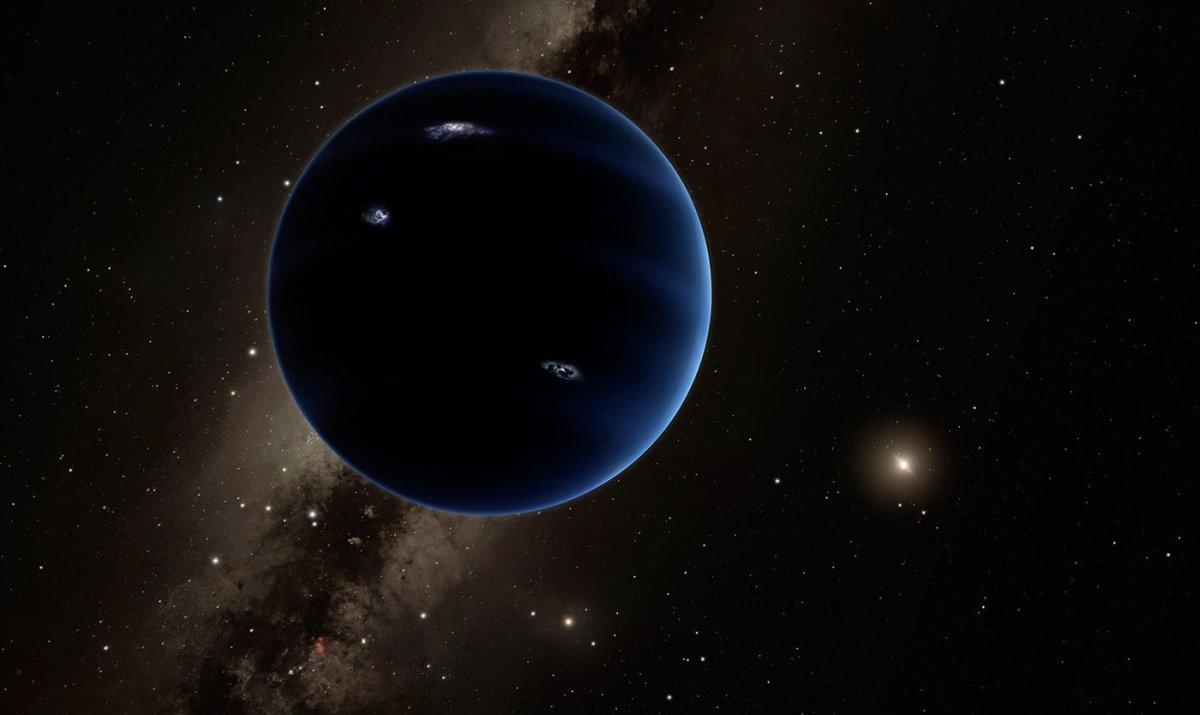Two years ago, scientists from the California Institute of Technology (Caltech) found evidence to suggest that a mysterious planet larger than Earth could be hiding beyond the orbit of Pluto, in the furthest reaches of the Solar System.
While the researchers didn't directly observe the hypothetical ninth planet—otherwise known as Planet Nine—they did predict its existence based on the strange orbits of a handful of so-called Trans-Neptunian objects (TNOs)—distant, icy worlds located beyond the orbit of Neptune. These TNOs are clustered together in a way that is extremely unlikely to have occurred by chance, indicating the presence of a planet-sized object that is influencing their orbits through its gravitational pull, the theory goes.
Since this discovery, scientists around the world have scrambled to investigate the predictions, but Planet Nine has remained elusive. Now, an international team of researchers has reported the discovery of another distant world with an extraordinary orbit—referred to as 2015 BP519—which, they say, bolsters the case for the ninth planet.
In a new paper, published on the online preprint server arXiv.org, the team described how it uncovered the space object in 2014 using data from the Dark Energy Survey (DES)—an international, collaborative effort to map a vast region of the skies and reveal the nature of the mysterious force that is accelerating the expansion of the universe, known as dark energy.
The object is peculiar because its orbit is very tilted in relation to the plane in which most objects that orbit the Sun lie.
"2015 BP519 is a small rocky object orbiting at 450 Astronomical Units [One AU is the average distance between the Earth and the Sun, or around 93 million miles]," Juliette Becker, a Michigan graduate student and lead author of the study, told Newsweek. "Its orbit is very elliptical, and it is inclined relative to the plane of the solar system: Its orbital inclination is 54 degrees, which is the highest out of all Trans-Neptunian objects."
After discovering it, the team tried to investigate 2015 BP519's origins using computer simulations of the Solar System. However, these tests were not able to adequately reproduce the object's inclined orbit.
But when the team added a ninth planet to their simulations, with properties exactly matching those predicted by the Caltech scientists in 2016, the orbit of 2015 BP519 suddenly made much more sense.
"Planet Nine is expected to generate some highly inclined TNOs, and BP519 is consistent with this picture," Becker said. "The findings are not 'proof,' but circumstantial evidence."

Some researchers, however, caution that Planet Nine may not be the only explanation for 2015 BP519's strange orbit.
Michele Bannister, a planetary astronomer from Queen's University Belfast, in the U.K., who was not involved in the study, told Newsweek that while the latest findings were "a great discovery," other scenarios could still account for its tilt.
"This object is unusual because it's on a high inclination," she said. "This can be used to maybe tell us some things about its formation process. There are a number of models that suggest you can probably put objects like this into the shape of orbit and the tilt of orbit that we see today."
One way you can do this, according to Bannister, is to take into account the fact that the early solar system probably contained 10,000 dwarf planets, in comparison to the 20 or so known examples that currently exist (Pluto is an example of a dwarf planet). The gravitational influence of these thousands of dwarf planets may have been sufficient to move 2015 BP519 into its inclined orbit, for example.
Another scenario which could produce the high inclination without including Planet Nine, according to Bannister's colleague at Queen's University, Pedro Lacerda—who was also not involved in the study—would be if the Solar System and another star flew past each other in the past, causing distant TNOs to be disturbed.
Whether or not 2015 BP519's orbit is evidence for the existence of Planet Nine, both Becker and Bannister agree that the new results will help to shine a light on the evolution of our planetary neighborhood.
"This new class of object can be used not only to inform the Planet Nine hypothesis, but also to better understand the history of the solar system," Becker concluded. "Hopefully, DES will be able to find more such objects."
Updated | This story has been updated to include comments and additional information from Juliette Becker and Pedro Lacerda.
Uncommon Knowledge
Newsweek is committed to challenging conventional wisdom and finding connections in the search for common ground.
Newsweek is committed to challenging conventional wisdom and finding connections in the search for common ground.
About the writer
Aristos is a Newsweek science reporter with the London, U.K., bureau. He reports on science and health topics, including; animal, ... Read more
To read how Newsweek uses AI as a newsroom tool, Click here.








